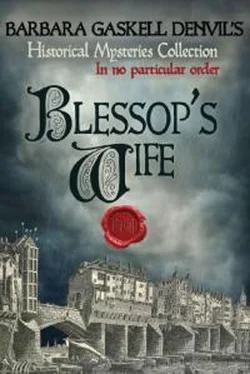History our Humbug? Authors Note
In the late 15th century at the time during which this book is set, events in England were moving fast. This is one of the most explosive periods in history, but sadly much contemporary documentation is lacking. There are verified facts – often overlooked even by historians – especially those with their own bias to promote – but much of the turmoil can be understood only via assumption and rumour.
Naturally this book is fictional. Most of my characters are fictional, and so is the plot. However, where real historical characters have been introduced, I have endeavoured to replicate those actions which would seem most probable under the circumstances, fitting what we know of their real aims and personalities. I must therefore point out that the theory concerning the death of King Edward IV by poison does not follow general historical opinion. There is no proof of this whatsoever. On the other hand, the puzzles and anomalies surrounding the king’s surprising death are there for all to study, and in particular Earl Rivers’ curious behaviour shortly prior to the king’s death is all absolutely accurate. This means there are some serious questions which have never yet been even remotely explained, and therefore the idea that King Edward IV might have been poisoned is not my own. The theory has existed for centuries.
The king’s death in 1483 was entirely unexpected. He was a fairly young man, dying just days before his forty-first birthday, and although there are definite indications that he was no longer a fit and active man, being possibly obese, he suffered from no specific known complaint. Nor was any medical diagnosis publicly acknowledged at the time. Those contemporaries who documented the situation came to varying conclusions, such as ‘a surfeit of –’, a ‘chill caught during inclement weather’, and ‘general gluttony’. It appears there were rumours of poison at the time but in the medieval era the rumour of poison accompanied the sudden and unexpected death of many powerful figures. However, it is strange that the king himself, the man most watched and cosseted in the entire country, should have died so unexpectedly and from causes unexplained. Medieval medicinal practice is generally supposed to have been ignorant and sometimes even dangerous, but doctors were not all as stupid as we sometimes now imagine, and the diagnosis (if not the treatment) for tumours, stroke, pneumonia, TB and many other fatal illnesses was thoroughly understood.
The suggestion that arsenic could well have been the cause has since been explored by Richard E. Collins, and presented in the book The Death of Edward IV , Part II by J. Dening and R. E. Collins, published in 1996.
For introducing me to this interesting theory, along with a huge amount of other insights and documented information on Richard III and his era, I would particularly like to thank Annette Carson for her fascinating and informative book RICHARD III: THE MALIGNED KING which is based on exemplary research principally using primary sources.
The other important scene in my book which differs fundamentally from traditional assumption, is the accusation and speedy execution of William, Lord Hastings. In a somewhat bizarre and unfinished story, later entitled ‘The History of King Richard III’, Sir Thomas More wrote in the second/third decade of the 16th century that Baron Hastings was arrested and arbitrarily beheaded within minutes of accusation without trial or justice of any kind. No document at the time of the event has corroborated the details of More’s story. The only reports remaining to us from that time simply state that Lord Hastings was accused of treason, (some claim his innocence, others saying nothing either way) and was executed accordingly. It does appear that the execution took place on the same day as the arrest, therefore leaving no time for a normal common-law trial by jury. The execution ‘within minutes’ claimed much later by Thomas More, however, is not only unsubstantiated but highly unlikely since the arrest took place during a full council meeting in the presence of some of the most powerful lords of the land. Because Richard III in his more mundane dealings with his subjects (both before and after becoming king) was particularly punctilious concerning matters of justice and law, this act of sudden execution has surprised many and led traditional thinkers to suppose it was an act of sudden fury, both illegal and unjust, proving Richard to be the ambitious villain they assume he was.
At the time Richard was not yet king. It is, however, probable that in his capacity as ‘Protector and Defender of the Realm against enemies both external and internal’, he could sanction indictment and trial where treason was concerned. And contemporary accounts definitely state that treason was the accusation. No details of what the treason entailed have survived, although a public proclamation was made within hours of the event. One report stated that Hastings was charged with laying an ambush for the Protector, bringing concealed arms into the council chamber so that he could attack him unawares. There was, of course, no lack of witnesses. Indeed, contemporary accounts profess no surprise nor outrage at the Protector taking justice into his own hands, indicating their acceptance of his right to do so. The law concerning treason at that time was not so clear cut.
Concurrently with his protectorship Richard also held the office of High Constable of England, conferred on him for life. This was a military office with its own Constable’s Court which tried cases of treason under the Law of Arms (as opposed to the common law). It was a court with authority to act summarily, without normal process of indictment, without trial by jury, and without appeal against the sentence of the Constable whose authority in such matters was second only to that of the king. We cannot know whether Richard conducted an ad hoc trial by empanelling persons and officers already present at the Tower – it is possible, but the Constable’s Court followed no strict procedure and was not required to keep records, although witnesses could be called. Certainly we cannot assume there was no trial – although this appears to be the assumption most people have adopted these days – based on the Thomas More stories.
If the powerful magnate Hastings had hatched a treasonous conspiracy (which certainly appears to be the case and was quoted at the time even by those hostile to Richard himself) a quick solution to a highly dangerous situation might have seemed the best deterrent. Other influential council members were present and would have both stood witness and discussed the necessary solution to the situation. Certainly this was not a vendetta against Hastings since several others were arrested at the same time – both within the council chamber and elsewhere. Indeed, arrests were carefully timed to coincide, even those taking place at some distance across London. Clearly the action was planned to minimise danger, and put a quick stop to whatever had been plotted and then discovered.
Therefore the picture I present in this book is certainly a possibility. Once again there exists no particular evidence that such an event occurred bur certainly, the Constable held the power to order a summary trial without jury in whatever place he wished, and without warning. He himself could be the judge. Whether he used it or not we cannot know, but since Richard held such power, I see no reason for him NOT to have used it… As usual with this controversial king, on the basis of present evidence the truth remains hidden. The myth has superseded the few actual facts we know for sure – and most of the contemporary documentation concerning his later life was quickly destroyed or wildly misrepresented by the victorious Tudor regime which followed.
Читать дальше












